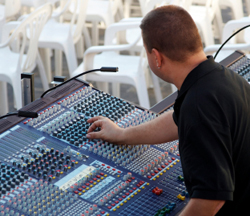
Power Play
The AC power provided at the venue is the energy that makes all things electronic happen. Regardless of the power distribution scheme, there will be a number of connections and should be safety devices in place to insure that every piece of gear gets the energy to operate safely and efficiently. All of these elements scale accordingly to the electrical load.
An ASE will always make sure that the connections to the building disconnect are made properly by the local electrician. I always tell the electrician the power configuration I need, and try to get a feel as to whether the electrician knows what I’m talking about.
I also let them know that I’ll be returning to evaluate their work, even tugging on all connections before the system is energized. This approach lets them know I expect everything to be shipshape for my check-up.
I also follow the feeder cables and check the connections. Stagehands sometimes neglect to turn cam-loc connectors completely to lock them, and more than once, I’ve found connector colors crossed up, which is common when working in the shadows under a stage.
Returning to the disconnect I tug on the wires, being sure to check the screw that attaches the ground lug to the panel chassis by pulling sideways a bit. If everything looks good, I’ll energize the system and check the voltage before connecting any gear to it.
While sound systems don’t appear to be power mongers like lighting rigs, there must be ample headroom to allow for dynamics in the music, providing amplifiers the ability to reproduce very high transients without clipping. Ask well in advance for adequate AC capacity.
A well-designed power distribution system will contain large feeder cables to handle this capacity and the means to distribute and balance the load on the service to achieve efficiency.
All Around Us
Understanding the interaction of a sound system with its surrounding space is one of the most challenging aspects of being the ASE. A bad room can take a well-designed rig and make it sound like… well, you know.
Most of the newer loudspeaker designs do a pretty good job of evenly distributing mid- and high-frequency energy. Line arrays, with their predictable coverage, have been nothing short of a revolution. Software programs now accurately predict sound pressure levels throughout the audience area.
Bass frequencies can be another thing altogether, however. Particularly in larger rooms, the biggest challenge is often getting a smooth low-end response.
